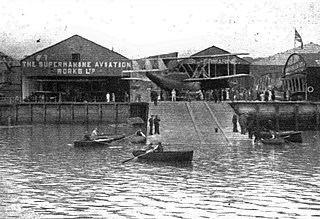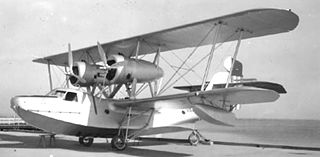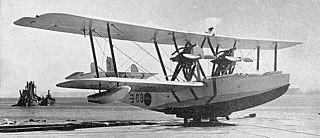Related Research Articles

Supermarine was a British aircraft manufacturer that is most famous for producing the Spitfire fighter plane during World War II as well as a range of seaplanes and flying boats, and a series of jet-powered fighter aircraft after World War II. The company had successes in the Schneider Trophy for seaplanes, with three wins in a row of 1927, 1929 and 1931.

A seaplane is a powered fixed-wing aircraft capable of taking off and landing (alighting) on water. Seaplanes are usually divided into two categories based on their technological characteristics: floatplanes and flying boats; the latter are generally far larger and can carry far more. Seaplanes that can also take off and land on airfields are in a subclass called amphibious aircraft, or amphibians. Seaplanes were sometimes called hydroplanes, but currently this term applies instead to motor-powered watercraft that use the technique of hydrodynamic lift to skim the surface of water when running at speed.

The Vickers Valentia was a 1920s British flying boat designed during the First World War.

The twin-engine F5L was one of the Felixstowe F series of flying boats developed by John Cyril Porte at the Seaplane Experimental Station, Felixstowe, England, during the First World War for production in America.

The Supermarine Southampton was a flying boat of the interwar period designed and produced by the British aircraft manufacturer Supermarine. It was one of the most successful flying boats of the era.

The English Electric P.5 Kingston was a British twin-engined biplane flying boat built by English Electric. When the English Electric Company was formed in 1918 from several companies, the Phoenix Dynamo Manufacturing Company brought with it the two prototype Phoenix P.5 Cork reconnaissance flying boats. Redesigned, the Cork reappeared as the English Electric P.5 Kingston with a production order for five aircraft.

The Felixstowe F.5 was a British First World War flying boat designed by Lieutenant Commander John Cyril Porte RN of the Seaplane Experimental Station, Felixstowe.
The Hiro Naval Arsenal at Kure (呉), Hiroshima prefecture, was a production facility for seaplanes, flying boats, and aero engines for the Imperial Japanese Navy before and during World War II. It was largely destroyed in a raid by B-29 Superfortresses on 5 May 1945.

The Supermarine Swan was a 1920s British experimental amphibian aircraft built by Supermarine at Woolston, Southampton. The single aircraft that was built was used for a passenger service between England and France.

The Naval Aircraft Factory PN was a series of open cockpit American flying boats of the 1920s and 1930s. A development of the Felixstowe F5L flying boat of the First World War, variants of the PN were built for the United States Navy by Douglas, Keystone Aircraft and Martin.

The Supermarine Commercial Amphibian was a passenger-carrying flying boat. The first aircraft to be designed by Supermarine's Reginald Mitchell, it was built at the company's works at Woolston, Southampton, for an Air Ministry competition that took place during September 1920. Based on the Supermarine Channel, the Amphibian was a biplane flying boat with a single engine, a wooden hull, unequal wingspans and a 350 horsepower (260 kW) Rolls-Royce Eagle engine. The front of the aircraft was designed to lift clear of the water prior to take-off. The pilot sat in an open cockpit behind two passengers.

The Hall PH was an American flying boat of the 1930s. It was a twin-engined biplane, developed from the Naval Aircraft Factory PN and could hence trace its lineage back to the Felixstowe flying boats of World War I. The PH was purchased in small numbers by the United States Navy and the United States Coast Guard. It remained in service with the Coast Guard until 1944, being used for anti-submarine and search and rescue duties.

The Supermarine Seal II was a British flying boat developed by Supermarine after it secured a British Air Ministry order for a prototype three-seater fleet spotter amphibian. The prototype, which had to be capable of landing on Royal Air Force (RAF) aircraft carriers, was designed by Supermarine’s R.J. Mitchell, who incorporated suggestions made after the Supermarine Commercial Amphibian achieved second place after it was entered for an Air Ministry competition in 1920.

The Norman Thompson N.T.2B was a British single-engined flying boat trainer of the First World War. A single-engined biplane, the N.T.2B was adopted as a standard flying boat trainer by the Royal Naval Air Service, training pilots for larger patrol flying boats such as the Felixstowe F.2.

The Hiro H1H was a 1920s Japanese bomber or reconnaissance biplane flying boat developed from the Felixstowe F.5 by the Hiro Naval Arsenal for the Imperial Japanese Navy. The aircraft were built by Hiro, the Yokosuka Naval Arsenal and Aichi.

The Hiro H2H, or "Navy Type 89 Flying boat", was a Japanese patrol flying boat of the 1930s. Designed and built by the Hiro Naval Arsenal, it was a twin-engined biplane that was operated by the Imperial Japanese Navy.

The Fairey N.4 was a 1920s British five-seat long range reconnaissance flying boat. Designed and built by the Fairey Aviation Company to meet an Admiralty requirement for a very large four-engined reconnaissance aircraft, it was the world's biggest flying boat when it first flew in 1923.

The Short N.3 Cromarty was a prototype British twin-engined biplane flying boat, designed towards the end of the First World War. Only a single example was built, which first flew in 1921 and was wrecked in 1922.
The Gosport Aircraft Company was a short-lived British aircraft manufacturer based at Gosport, Hampshire formed at the start of the First World War by Sir Charles Allom of White, Allom & Company and Charles Ernest Nicholson of Camper and Nicholsons boat-builders. The company built a number of flying-boats for the British government including the hull for the Fairey Atalanta which at the time was the largest flying-boat hull built in the world.
References
- ↑ Andrews and Morgan 1987, p.87